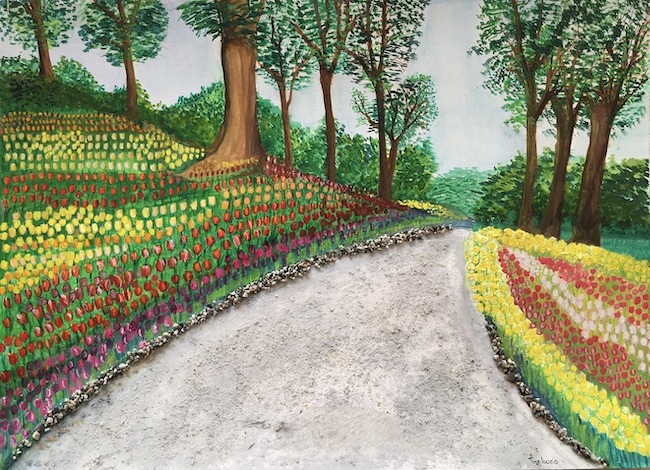Descrivere sensazioni ed emozioni che appartengono all’era attuale, quel complesso e intricato groviglio di pragmatismo e sensibilità, di isolamento tecnologico e ricerca di un senso di comunità ormai sfuggito, è la linea guida di molti artisti contemporanei che armonizzano quel loro indecifrabile sentire a uno stile più o meno criptico, ermetico oppure decisamente figurativo e aderente alla realtà in tutte le sue sfumature psicologiche, emozionali ed enigmatiche. Esistono però alcuni creativi che hanno un approccio differente, che sentono la necessità di mantenersi collegati al lato più spontaneo, più innocente del proprio sguardo sul mondo, pur non perdendo il contatto con la contingenza, con un’oggettività che viene superata in virtù di quell’interpretazione maggiormente innocente e positiva. La protagonista di oggi appartiene a quel gruppo di artisti.
Quando alla fine del Diciannovesimo secolo Henri Rousseau partecipò al Salon des Indépendendts di Parigi, il suo tipo di arte, cosiddetta ingenua, caratterizzata da semplicità esecutiva sia dal punto di vista della stesura del colore, sempre piatto e pieno, che nella realizzazione dell’immagine d’insieme priva di prospettiva e di struttura classica, suscitò interesse in una parte di intellettuali che vennero colpiti esattamente dall’immediatezza delle opere, in grado proprio in virtù della loro spontaneità di raggiungere l’osservatore che non poteva fare a meno di immergersi in quei paesaggi incantati, spesso frutto della fantasia dell’esecutore. Qualche decennio dopo il Naif divenne un vero e proprio stile ufficialmente riconosciuto e diffuso non solo in Europa, in particolar modo in Francia, Italia e Jugoslavia, bensì anche in Russia e negli Stati Uniti, dove le linee guida furono personalizzate e modificate rispetto a quelle iniziali, adattate all’espressività di ciascun aderente alla corrente pittorica. Dal mondo bizzarro e pittoresco, popolato da giocolieri, atleti, clown e personaggi del circo dei dipinti di Camille Bombois si passava alla natura innevata e ai paesini incantati del croato Ivan Generalić, dagli animali voraci e ruggenti di Antonio Ligabue ai minuziosi scorci cittadini popolati da miriadi di persone troppo piccole per essere distinguibili ma troppo numerose per passare inosservate di Orneore Metelli, dall’assoluta stilizzazione del mondo animale di Maria Primachenko, che sconfina, o può essere considerata anticipazione del Graffitismo, per giungere all’universo a taglie forti di Fernando Botero, le cui opere non smettono di affascinare il mondo della critica e degli appassionati; tutti questi grandi nomi dell’arte del Novecento hanno contribuito a mantenere vivo l’intento primordiale del movimento, quell’approccio fanciullesco alla realtà quotidiana che, grazie al loro sguardo innocente e a tratti ingenuo, poteva essere trasformata in un luogo sognante e pieno di meraviglie.
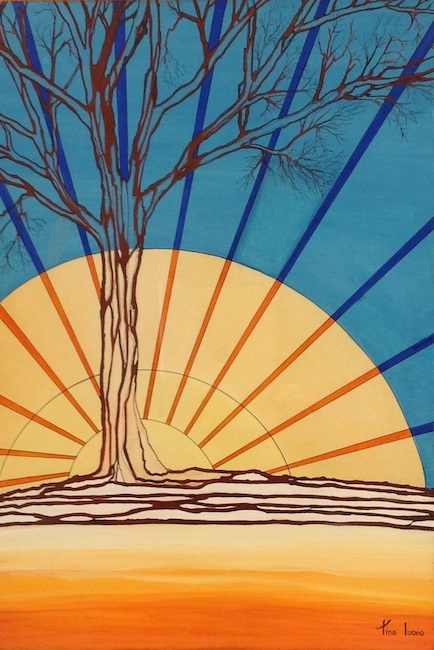
L’artista torinese Tina Iuorio, dopo aver lavorato anni in nell’ufficio commerciale di un’azienda orafa, decide di far sentire la sua voce creativa scegliendo esattamente il Naif, stile pittorico grazie al quale può esprimere quanto sia importante, malgrado la seriosità della vita o del percorso professionale, mantenere vivo il bambino che si nasconde dietro ogni adulto, attraverso cui ci si lascia andare all’ammirazione delle bellezze della natura o di un paesaggio senza per questo dimenticare di osservare con realismo tutto ciò che è parte del mondo contemporaneo.
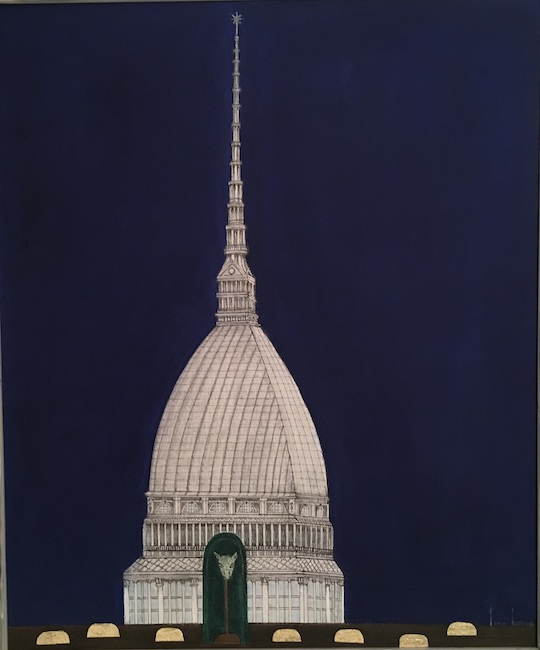
È uno sguardo rapito quello che usa la Iuorio, con cui di poggia sul ricordo di un panorama, di un bosco, di una collina su cui svettano le case di una piccola comunità, tanto quanto è materno nei confronti degli accadimenti che si susseguono velocemente nel rapido vivere attuale e che spesso sovvertono l’ordine preesistente, così come delle reazioni che vede manifestarsi al giungere di quelle circostanze; il suo tocco pittorico è delicato, fatto di linee essenziali e semplici, come d’altronde lo stile da lei scelto suggerisce, a tratti sognante quasi come se la memoria arricchisse il vissuto di emozioni che non possono fare a meno di fuoriuscire con chiarezza e immediatezza. Le tonalità sono vivaci ma tenui, quasi come se tinte troppo forti e decise potessero rompere l’incantesimo tra ciò che viene visto e ciò che il processo pittorico ha bisogno di rivelare e così l’ambiente si accorda a quella sottile magia che avvolge le immagini dell’artista.
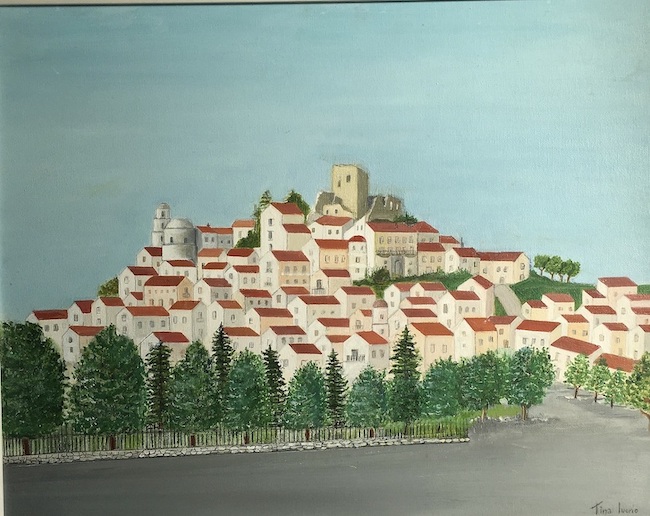
Nel dipinto Il mio paese Naif emerge tutta la nostalgia di un momento vissuto forse nel frangente dell’allontanamento, quando non era possibile non voltarsi indietro per ammirare quella collina, quelle case e le vie dove era stato vissuto un periodo intenso, poco importa se lungo o breve, dell’esistenza all’interno del quale si erano incontrate persone, si erano respirati odori e assaggiati sapori destinati a restare indelebili nella memoria. I tetti ordinati, gli alberi ai lati della strada, tutto sembra appartenere a una fiaba, a quei paesaggi in cui le storie iniziano a essere raccontate, e forse è proprio da quel luogo che è cominciata la fase di crescita, la storia di Tina Iuorio.
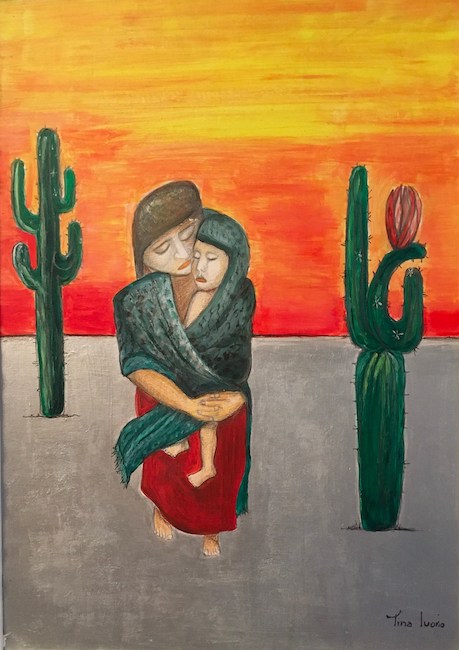
Tanto spontaneo è il suo ricordo quanto tenera è la fantasia che la conduce a omaggiare una delle più grandi rappresentanti femminili della pittura di ogni epoca, Frida Kahlo, a cui dedica un paesaggio messicano narrato con la semplicità dei toni aranciati del tramonto, del verde scuro dei cactus, del grigio della terra, ponendo al centro della scena una maternità, condizione che la grande rappresentante della pittura internazionale ha sempre sognato ma non ha mai potuto realizzare a causa dell’incidente avuto da giovane e che ha compromesso ogni possibilità di portare avanti una gravidanza. Il volto della donna è ripiegato verso il bambino, a proteggerlo, ed evoca nell’osservatore un senso di rimpianto; è un’interpretazione delle sensazioni della Kahlo, di quel senso di mancato abbraccio nei confronti di un figlio che le è stato negato e che almeno attraverso un’opera Tina Iuorio desidera regalarle.
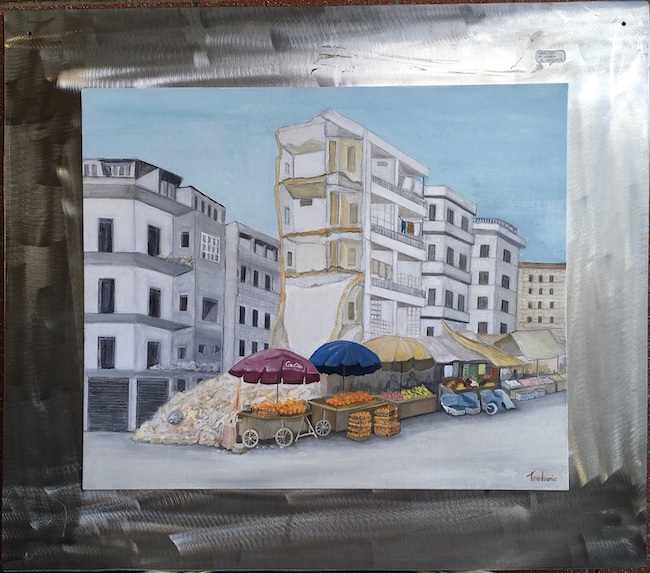
Nella tela Aleppo, nonostante la guerra un mercato, l’artista conferma una sensibilità fuori dal comune che la induce a scorgere la bellezza di frammenti di normalità anche in una situazione in cui tutto sembra essere perduto, dove ogni cosa ha modificato il suo significato e la sua importanza perché la priorità è quella di sopravvivere; eppure le persone hanno bisogno di tornare, o forse sarebbe meglio dire aggrapparsi, a un’abitudine, a una quotidianità anche se timidamente, anche se timorosamente, perché i banchi del mercato sono soli in mezzo al silenzio in attesa che le persone decidano di sfidare il pericolo e uscire dalle loro case per comprare ciò di cui hanno bisogno. La Iuorio sottolinea l’attaccamento alla vita e al bisogno di trovare il sostentamento sia da parte dei mercanti, per cui è necessario vendere per nutrire i propri figli, sia da parte di chi non affolla le strade ma che lentamente e gradualmente troverà il coraggio di uscire per riprendersi quella parte di normalità.
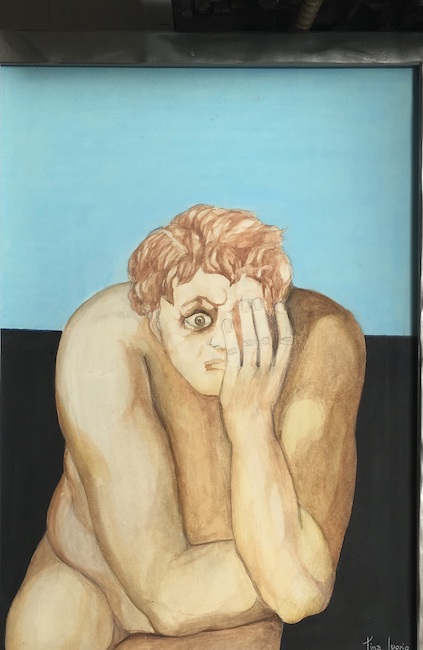
In Sgomento l’artista mostra tutta la sua capacità di ascolto, di osservazione empatica di ciò che la circonda o che incontra nel suo cammino, comprese quelle sensazioni condivise che appartengono all’essere umano nell’epoca attuale, un lungo periodo di paura, di incapacità di rialzarsi proprio perché sorpresi nel momento più inatteso, in una fase in cui l’umanità correva verso un progresso e un’autoreferenzialità crescenti trovandosi da un giorno all’altro a rivedere tutte le priorità, tutto il percorso effettuato, ogni valutazione fatta che, davanti a quel cambiamento sembrava perdere di rilevanza. Malgrado la sensazione descritta nel titolo, le tonalità del dipinto sono chiare, in risalto rispetto al fondo scuro, quasi come se Tina Iuorio volesse infondere nell’osservatore la speranza che prima o poi si verificherà un ritorno alla normalità, probabilmente cambiata e più ricca di emozioni e significati che erano andati perduti; emerge la positività dell’artista nel valutare quanto ciascun evento, anche il più negativo, porti con sé risvolti favorevoli che si possono scoprire solo a distanza di tempo.
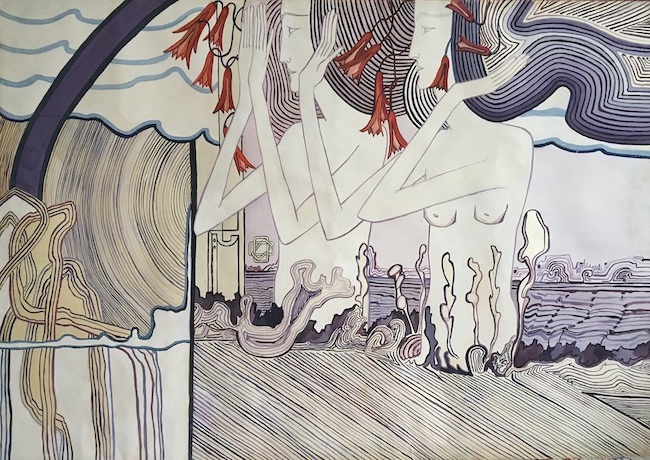
Tina Iuorio partecipa regolarmente a mostre collettive soprattutto nel territorio piemontese, tra le principali quella presso la Galleria Artemisia di Torino e quelle presso l’Accademia di San Mauro e San Grato.
TINA IUORIO-CONTATTI
Email: tina.iuorio@gmail.com
Facebook: https://www.facebook.com/tina.iuorio
Instagram: https://www.instagram.com/tinaiuorio/
All the spontaneity of the Naif in Tina Iuorio’s in-depth study of contemporary reality
Describing sensations and emotions that belong to the current era, that complex and intricate tangle of pragmatism and sensitivity, of technological isolation and the search for a sense of community that has now escaped, is the guideline of many contemporary artists who harmonise their indecipherable feelings with a style that is more or less cryptic, hermetic or decidedly figurative and adherent to reality in all its psychological, emotional and enigmatic nuances. However, there are some creatives who have a different approach, who feel the need to keep in touch with the more spontaneous, more innocent side of their view of the world, without losing touch with contingency, with an objectivity that is overcome by virtue of that more innocent and positive interpretation. Today’s protagonist belongs to that group of artists.
When Henri Rousseau took part in the Salon des Indépendendts in Paris at the end of the 19th century, his so-called naïve art, characterised by simplicity of execution both in terms of the application of colour, always flat and full, and in the realisation of the overall image, devoid of perspective and classical structure, aroused the interest some intellectuals who were struck by the immediacy of the artworks, which, precisely because of their spontaneity, were able to reach the observer who could not help but immerse himself in those enchanted landscapes, often the result of the artist’s imagination. A few decades later, Naif became an officially recognised and widespread style not only in Europe, especially in France, Italy and Yugoslavia, but also in Russia and the United States, where the guidelines were customised and modified from the initial ones, adapted to the expressiveness of each painter. From the bizarre and picturesque world of jugglers, athletes, clowns and circus characters in the paintings of Camille Bombois to the snowy nature and enchanted villages of Croatian artist Ivan Generalić, from the voracious and roaring animals of Antonio Ligabue to the detailed cityscapes populated by myriads of people too small to be distinguishable but too numerous to go unnoticed by Orneore Metelli, from the absolute stylisation of the animal world by Maria Primachenko, which borders on, or can be considered as an anticipation of, Graffiti Art, to the plus size universe of Fernando Botero, whose paintings never cease to fascinate the world of critics and enthusiasts; All these great names in 20th-century art have contributed to keeping alive the movement’s primordial intent, that childlike approach to everyday reality which, thanks to their innocent and sometimes naive gaze, could be transformed into a dreamy place full of wonders.
After working for many years in the sales office of a goldsmith’s company, Turin artist Tina Iuorio decided to make her creative voice heard by choosing Naif, a style of painting through which she can express how important it is, despite the seriousness of life or a professional career, to keep alive the child that hides behind every adult, through which one can let oneself go in admiration of the beauty of nature or a landscape without forgetting to observe with realism everything that is part of the contemporary world. It’s an enraptured gaze that of Iuorio, that rests on the memory of a landscape, a wood, a hill on which the houses of a small community stand out, as much as it is maternal with regard to the events that quickly happen in today’s fast-moving world and which often subvert the pre-existing order, as well as the reactions she sees manifested when these circumstances arise; her pictorial touch is delicate, made up of essential and simple lines, as the style she has chosen suggests, at times dreamy, almost as if memory enriched the experience with emotions that cannot fail to emerge clearly and immediately. The tones are lively but subdued, almost as if colours that are too strong and decisive could break the spell between what is seen and what the pictorial process needs to reveal, and so the environment accords with the subtle magic that envelops the artist’s images. In the painting Il mio paese Naif (My Naif Town), emerges all the nostalgia of a moment experienced perhaps at the juncture of leaving, when it was impossible not to look back and admire that hill, those houses and streets where an intense period, it doesn’t matter if it’s long or short, it’s a place where you have met people, breathed in smells and tasted flavours that will remain indelibly in your memory.
The tidy roofs, the trees on either side of the road, everything seems to belong to a fairy tale, to those landscapes where stories begin to be told, and perhaps it was from that place that Tina Iuorio’s story began. Her recollection is as spontaneous as the tender imagination that leads her to pay homage to one of the greatest female painters of all times, Frida Kahlo, to whom she dedicates a Mexican landscape narrated with the simplicity of the orange tones of the sunset, the dark green of the cacti and the grey of the earth, placing motherhood at the centre of the scene, a condition that the great representative of international painting always dreamed of but was never able to achieve because of the accident she had when she was young, which compromised any possibility of carrying a pregnancy. The woman’s face is turned towards the child, to protect it, and evokes in the observer a sense of regret; it is an interpretation of Kahlo’s feelings, of that sense of failure to embrace a child that was denied her and that Tina Iuorio wishes to give her, at least through an artwork. In the canvas Aleppo, nonostante la guerra un mercato (Aleppo, despite the war a market), the artist confirms an uncommon sensitivity that leads her to see the beauty of fragments of normality even in a situation where everything seems to be lost, where everything has changed its meaning and importance because the priority is to survive; and yet people need to return, or perhaps it would be better to say cling, to a habit, to a daily routine, even if shyly, even if fearfully, because the market stalls are alone in the middle of the silence waiting for people to decide to defy danger and come out of their homes to buy what they need. Iuorio emphasises the attachment to life and the need to find sustenance both on the part of the merchants, for whom it is necessary to sell in order to feed their children, and on the part of those who do not crowd the streets but who slowly and gradually find the courage to go out to take back that part of normality. In Sgomento (Dismay) the artist shows all her ability to listen, to empathically observe what surrounds her or what she encounters on her path, including those shared feelings that belong to human beings in the current era, a long period of fear, of inability to get up again precisely because we are surprised at the most unexpected moment, at a time when mankind was racing towards increasing progress and self-referentiality, finding itself from one day to the next reviewing all its priorities, all the path it had taken, all the assessments it had made, which, in the face of that change, seemed to lose their relevance. Despite the sensation described in the title, the tones of the painting are light, standing out against the dark background, almost as if Tina Iuorio wanted to instil in the observer the hope that sooner or later there will be a return to normality, probably changed and richer in emotions and meanings that had been lost; the artist’s positivity emerges in assessing how each event, even the most negative, brings with it favourable implications that can only be discovered after some time. Tina Iuorio regularly takes part in group exhibitions, especially in the Piedmont area, the most important of which are those held at the Artemisia Gallery in Turin and at the Academy of San Mauro and San Grato.


